The History Of Ferrari

Ferrari S.p.A. is an Italian sports car manufacturer based in Maranello, Italy. Founded by Enzo Ferrari in 1928 as Scuderia Ferrari, the company sponsored drivers and manufactured race cars before moving into production of street-legal vehicles in 1947 as Ferrari S.p.A.. Throughout its history, the company has been noted for its continued participation in racing, especially in Formula One, where it has enjoyed great success.
After years of financial struggles, Enzo Ferrari sold the company's sports car division to the Fiat group in 1969 to ensure continued financial backing. Enzo Ferrari retained control of the racing division until his death in 1988 at the age of 90. Earlier that year he had overseen the launch of the Ferrari F40; the last new Ferrari to be launched before his death, and arguably one of the most famous supercars ever made.
Ferrari also has an internally managed merchandising line that licenses many products bearing the Ferrari brand, including eyewear, pens, pencils, electronic goods, perfume, clothing, high-tech bicycles, watches, cell phones, and even laptop computers.
In 2007 the Financial Times put Ferrari at the top of its list of 100 Best Workplaces in Europe.
Main article: History of Ferrari1929–1948
Enzo Ferrari never intended to produce road cars when he formed Scuderia Ferrari (literally "Ferrari Stable", and usually used to mean "Team Ferrari", it is correctly pronounced "skoo deh REE ah") in 1929 as a sponsor for amateur drivers headquartered in Modena. Ferrari prepared and successfully raced various drivers in Alfa Romeo cars until 1938, when he was hired by Alfa Romeo to head their motor racing department.
In 1941, Alfa Romeo was confiscated by the Fascist government of Benito Mussolini as part of the Axis Powers' war effort. Enzo Ferrari's division was small enough to be unaffected by this. Because he was prohibited by contract from racing for four years, the Scuderia briefly became Auto Avio Costruzioni Ferrari, which ostensibly produced machine tools and aircraft accessories. Also known as SEFAC (Scuderia Enzo Ferrari Auto Corse), Ferrari did in fact produce one race car, the Tipo 815, in the non-competition period. It was the first actual Ferrari car (it debuted at the 1940 Mille Miglia), but due to World War II it saw little competition. In 1943 the Ferrari factory moved to Maranello, where it has remained ever since. The factory was bombed by the Allies in 1944 and rebuilt in 1946, after the war ended, and included a works for road car production. Until Il Commendatore's death, this would remain little more than a source of funding for his first love, racing.
1947–present
The first Ferrari road car was the 1947 125 S, powered by a 1.5L V12 engine; Enzo Ferrari reluctantly built and sold his automobiles to fund Scuderia Ferrari.[citation needed]
While his beautiful and fast cars quickly gained a reputation for excellence, Enzo maintained a famous distaste for his customers.[citation needed]
Sports car racing
In 1949, Luigi Chinetti drove a 166M to Ferrari's first win in motorsports, the 24 Hours of Le Mans. Ferrari went on to dominate the early years of the World Sportscar Championship which was created in 1953, winning the Manufacturers Championship seven out of its first nine years.
When the championship changed formats in 1962, Ferrari earned championships in at least one class until 1966, then again in 1968. Ferrari would win one final championship in 1972 before Enzo decided to leave sports car racing and concentrate Scuderia Ferrari solely on Formula One.
During Ferrari's seasons of the World Sportscar Championship, they also gained more wins at the 24 Hours of Le Mans, with the factory team earning their first in 1954. Another win would come in 1958, followed by five consecutive wins from 1960 to 1964. Luigi Chinetti's North American Racing Team (NART) would take Ferrari's final victory at Le Mans in 1965.
Although Scuderia Ferrari no longer participated in sports cars after 1973, they have occasionally built various successful sports cars for privateers. These include the 512BB/ LM in the 1970s, the 333 SP which won the IMSA GT Championship in the 1990s, and currently the F430 GT2 and GT3 which are currently winning championships in their respective classes.
Formula One
Main article: Scuderia FerrariThe Scuderia joined the Formula One World Championship in the first year of its existence, 1950. José Froilán González gave the team its first victory at the 1951 British Grand Prix.
Alberto Ascari gave Ferrari its first Drivers Championship a year later. Ferrari is the oldest team left in the championship, not to mention the most successful: the team holds nearly every Formula One record. As of 2007[update], the team's records include 15 World Drivers Championship titles (1952, 1953, 1956, 1958, 1961, 1964, 1975, 1977, 1979, 2000, 2001, 2002, 2003, 2004 and 2007) 16 World Constructors Championship titles 1961, 1964, 1975, 1976, 1977, 1979, 1982, 1983, 1999, 2000, 2001, 2002, 2003, 2004, 2007 and 2008, 201 Grand Prix victories, 4753.27 points, 603 podium finishes, 195 pole positions, 12,489 laps led, and 205 fastest laps in 758 Grands Prix contested.
Notable Ferrari drivers include Tazio Nuvolari, Juan Manuel Fangio, Luigi Chinetti, Alberto Ascari, Wolfgang von Trips, Phil Hill, Olivier Gendebien, Mike Hawthorn, Peter Collins, John Surtees, Lorenzo Bandini, Ludovico Scarfiotti, Jacky Ickx, Mario Andretti, Clay Regazzoni, Niki Lauda, Carlos Reutemann, Jody Scheckter, Gilles Villeneuve, Didier Pironi, Michele Alboreto, Gerhard Berger, Nigel Mansell, Alain Prost, Jean Alesi, Eddie Irvine, Rubens Barrichello, Michael Schumacher, Kimi Räikkönen, and Felipe Massa.
The Scuderia Ferrari drivers for the 2006 F1 season were Michael Schumacher and Felipe Massa. At the end of the 2006 season the team courted controversy by continuing to allow Marlboro to sponsor them after they, along with the other F1 teams, made a promise to end sponsorship deals with tobacco manufacturers. A five year deal worth a reported $500 million was agreed.[citation needed]
The drivers competing for 2008 were Felippe Massa and defending champion Kimi Räikkönen (both retained from 2007). Massa finished the season as runner-up to McLaren's Lewis Hamilton, with Räikkönen third. Massa and Räikkönen have again been signed by Ferrari for the 2009 season.
A1 Grand Prix
On October 11 2007, it was announced that Ferrari will power all A1 Grand Prix cars from the 2008-09 season.
The famous symbol of the Ferrari race team is a black prancing stallion on a yellow shield, usually with the letters S F (for Scuderia Ferrari), with three stripes of green, white and red (the Italian national colors) at the top. The road cars have a rectangular badge on the hood (see picture above), and, optionally, the shield-shaped race logo on the sides of both front wings, close to the door.
On June 17, 1923, Enzo Ferrari won a race at the Savio track in Ravenna where he met the Countess Paolina, mother of Count Francesco Baracca, an ace of the Italian air force and national hero of World War I, who used to paint a horse on the side of his planes. The Countess asked Enzo to use this horse on his cars, suggesting that it would bring him good luck. The original "prancing horse" on Baracca's airplane was painted in red on a white cloud-like shape, but Ferrari chose to have the horse in black (as it had been painted as a sign of grief on Baracca's squadron planes after the pilot was killed in action) and he added a canary yellow background as this is the color of the city of Modena, his birthplace. The Ferrari horse was, from the very beginning, markedly different from the Baracca horse in most details, the most noticeable being the tail that in the original Baracca version was pointing downward.
Ferrari has used the cavallino rampante on official company stationery since 1929. Since the Spa 24 Hours of July 9, 1932, the cavallino rampante has been used on Alfa Romeos raced by Scuderia Ferrari.
The motif of a prancing horse is old, it can be found on ancient coins. A similar black horse on a yellow shield is the Coat of Arms of the German city of Stuttgart, home of Mercedes-Benz and the design bureau of Porsche, both being main competitors of Alfa and Ferrari in the 1930s. The city's name derives from Stutengarten, an ancient form of the German word Gestüt, which translates into English as stud farm and into Italian as scuderia. Porsche also includes the Stuttgart sign in its corporate logo, centred in the emblem of the state of Württemberg. Stuttgart's Rössle has both rear legs firmly planted on the soil, like Baracca's horse, but unlike Ferrari's cavallino.
Fabio Taglioni used the cavallino rampante on his Ducati motorbikes, as Taglioni was born at Lugo di Romagna like Baracca, and his father too was a military pilot during WWI (although not part of Baracca's squadron, as is sometimes mistakenly reported). As Ferrari's fame grew, Ducati abandoned the horse- perhaps the result of a private agreement between the two companies.
The cavallino rampante is now a trademark of Ferrari. Cavallino Magazine uses the name, but not the logo. However, other companies use similar logos: Avanti, an Austrian company operating over 100 filling stations, uses a prancing horse logo which is nearly identical to Ferrari's, as does Iron Horse Bicycles. Many pay homage to the Ferrari logo, e.g. the Jamiroquai album Travelling Without Moving.
Main article: Rosso corsaSince the 1920s, Italian race cars of Alfa Romeo, Maserati and later Ferrari and Abarth were (and often still are) painted in "race red" (Rosso Corsa). This was the customary national racing color of Italy, as recommended between the World Wars by the organizations that later would become the FIA. It refers to the nationality of the competing team, not that of the car manufacturer or driver. In that scheme, French-entered cars like Bugatti were blue, German like Benz and Mercedes white (since 1934 also bare sheet metal silver), and British green such as the mid 1960s Lotus and BRM, for instance.
Curiously, Ferrari won the 1964 World championship with John Surtees by competing the last two races in North America with cars painted in the US-American race colors white and blue, as these were not entered by the Italian factory themselves, but by the U.S.-based North American Racing Team (NART) team. This was done as a protest concerning arguments between Ferrari and the Italian Racing Authorities regarding the homologation of a new mid-engined Ferrari race car.
Ferrari has had a long standing relationship with Shell Oil. It is a technical partnerships with Ferrari and Ducati to test as well as supply fuel and oils to the Formula One, MotoGP and World Superbike racing teams. For example, the Shell V-Power premium gasoline fuel has been developed with the many years of technical expertise between Shell and Ferrari.
Until the early 1980s, Ferrari followed a three-number naming scheme based on engine displacement:
- V6 and V8 models used the total displacement (in decilitres) for the first two digits and the number of cylinders as the third. Thus, the 206 was a 2.0L V6 powered vehicle, while the 348 used a 3.4L V8, although, for the F355, the last digit refers to 5 valves per cylinder. Upon introduction of the 360 Modena, the digits for V8 models (which now carried a name as well as a number) refer only to total engine displacement. The numerical indication aspect of this name has carried on to the current V8 model, the F430.
- V12 models used the displacement (in cubic centimetres) of one cylinder. Therefore, the famed 365 Daytona had a 4390cc V12. However, some newer V12-engined Ferraris, such as the 599, have three-number designations that refer only to total engine displacement.
- Flat 12 (boxer) models used the displacement in litres. Therefore, the 512BB was five litre flat 12 (a Berlinetta Boxer, in this case). However, the original Berlinetta Boxer was the 365 GT4 BB, which was named in a similar manner to the V12 models.
- Some models, such as the 1980 Mondial and the 1984 Testarossa did not follow a three-number naming scheme.
Most Ferraris were also given designations referring to their body style. In general, the following conventions were used:
- M ("Modificata"), placed at the end of a model's number, denotes a modified version of its predecessor and not a complete evolution (see F512M and 575M Maranello).
- GTB ("Gran Turismo Berlinetta") models are closed Berlinettas, or coupes.
- GTS ("Gran Turismo Spyder") in older models, are open Spyders (spelt "y"), or convertibles (see 365GTS4); however, in more recent models, this suffix is used for targa top models (see Dino 246GTS, and F355 GTS; the exception being the 348 TS, which is the only targa named differently). The convertible models now use the suffix "Spider" (spelt "i") (see F355 Spider, and 360 Spider).
This naming system can be confusing, as some entirely different vehicles used the same engine type and body style. Many Ferraris also had other names affixed (like Daytona) to identify them further. Many such names are actually not official factory names. The Daytona name commemorates Ferrari's triple success in the February 1967 24 Hours of Daytona with the 330P4. Only in the 1973 Daytona 24 Hours, a 365 GTB4 model run by NART, who raced Ferrari's in America) ran second, behind a Porsche 911.
The various Dino models were named for Enzo's son, Dino Ferrari, and were marketed as Dinos by Ferrari and sold at Ferrari dealers -- for all intents and purposes they are Ferraris.
In the mid 1990s, Ferrari added the letter "F" to the beginning of all models (a practice abandoned after the F512M and F355, but adopted again with the F430).
Road cars
Sports cars
Ferrari's first models were sports/ racing cars quite different from the grand touring models that followed. See below for a complete list.
2-seat Gran Turismo
Ferrari quickly moved into the Gran Turismo market, and the bulk of the company's sales remain in this area.
- 1949 166 Inter
- 1950 195 Inter
- 1951 212 Inter
- 1951 342 America
- 1953 375 MM
- 1953 250 Europa
- 1953 375 America
- 1954 250 Europa GT
- 1956 410 Superamerica
- 1956-1963 250 GT Europa/ Boano/ Ellena/ Pininfarina Coupe/ Lusso
- 1957-1960 250 GT Berlinetta/ Cabriolet/ California Spyder/ SWB
- 1960 400 Superamerica
- 1964-1968 275
- 1964-1965 275 GTB Coupe
- 1964-1965 275 GTS Spyder
- 1966-1968 275 GTB/ 4
- 1964 500 Superfast
- 1964 330
- 1966 330 GTC Coupe
- 1966 330 GTS Spyder
- 1966 365 California
- 1968 365
- 1968-1969 365 GTC Coupe
- 1969-1970 365 GTS Spyder
- 1968-1973 365 Daytona
- 1968 365 GTB/ 4 Coupe
- 1968 365 GTS/ 4 Spyder
- 1996-2001 550 Maranello
- 1996-2001 550 Maranello
- 2001 550 Barchetta
- 2002-2006 575M Maranello
- 2002-2006 575M Maranello
- 2005 575M Superamerica
- 2007 599 GTB Fiorano
Mid-engine V6/ V8
The Dino was the first mid-engined Ferrari. This layout would go on to be used in most Ferraris of the 1980s and 1990s. V6 and V8 Ferrari models make up well over half of the marque's total production.
- 1968-1974 Dino
- 1968-1969 Dino 206 GT
- 1969-1974 246GT Berlinetta, or Coupe
- 1972-1974 246GTS (targa top) Spyder
- 1975-1989 208/ 308/ 328 GTB/ GTS
- 1975-1977 308 GTB (GRP)
- 1977-1979 308 GTB and GTS
- 1980-1981 208 GTB & GTS
- 1980-1981 308 GTBi & GTSi
- 1982-1985 208 GTB/ GTS Turbo
- 1982-1985 308 GTB/ GTS Quattrovalvole
- 1986-1989 328 GTB & GTS
- 1986 208 GTB/ GTS Turbo
- 1989-1994 348
- 1989-1993 348 TB & TS
- 1993-1994 348 GTB, GTS & Spider
- 1994-1999 F355
- 1994-1999 F355 Berlinetta & GTS
- 1995-1999 F355 Spider
- 1995 F355 Challenge
- 1998-1999 355 F1
- 1999-2004 360
- 1999-2004 360 Modena & Spider
- 2003-2004 360 Challenge Stradale
- 2005 F430
- 2005 F430 & F430 Spider
- 2007 430 Scuderia
- 2009 Scuderia Spider 16M
Mid-engine 2+2
For a time, Ferrari built 2+2 versions of its mid-engined V8 cars. Although they looked quite different from their 2-seat counterparts, both the GT4 and Mondial were closely related to the 308 GTB.
- 1974-1980 208/ 308 GT4
- 1974-1975 Dino 308 GT4
- 1976-1980 308 GT4
- 1975-1980 208 GT4
- 1980-1993 Mondial
- 1980-1981 Mondial 8
- 1982-1985 Mondial QV (Quattrovalvole) Coupe
- 1983-1985 Mondial QV Cabriolet
- 1985-1989 3.2 Mondial Coupe & 3.2 Mondial Cabriolet
- 1989-1993 Mondial T Coupe & Mondial T Cabriolet
Front-engine 2+2
The company has also produced front-engined 2+2 cars, culminating in the current 612 Scaglietti and upcoming California.
- 1960-1963 250
- 1960-1963 250 GT/ E 2+2
- 1964-1967 330
- 1964-1965 330 GT 2+2
- 1965-1967 330 GT 2+2 Mk II
- 1967-1971 365
- 1967-1971 365 GT 2+2
- 1968-1973 365 Daytona
- 1971-1972 365 GTC/ 4
- 1972-1976 365 GT4 2+2
- 1976-1989 400 & 412
- 1976 400 Automatic
- 1979 400i
- 1985 412
- 1992-2003 456 & 456 M
- 1992-1997 456 GT & GTA Coupe
- 1998-2003 456 M GT & M GTA Coupe
- 2004 612 Scaglietti
- 2009 Ferrari California
Mid-engine 12-cylinder
Ferrari entered the mid-engined 12-cylinder fray with the Berlinetta Boxer in 1973. The later Testarossa remains one of the most famous Ferraris.
- 1973-1984 Berlinetta Boxer
- 1973-1976 365 GT4 BB
- 1976-1981 512 BB
- 1981-1984 512i BB
- 1984-1996 Testarossa
- 1984-1992 Testarossa
- 1992-1994 512 TR
- 1994-1996 F512 M
Supercars
The company's loftiest efforts have been in the supercar market.
- 1962-1964 250 GTO
- 1984-1985 288 GTO
- 1987-1992 F40
- 1995-1997 F50
- 1996 F50 GT
- 2003-2005 Enzo
- 2006 FXX
Competition cars
Current
- 2009 F60
- 2007 599 GTB Fiorano
- 2006-2008 Ferrari F430
- 2006 F430 GT
- 2006 F430 Pista
- 2006 FXX
Past
- Sports cars
- 1940 AAC 815
- 1947 125 Sport
- 1947 159 Sport
- 1948 166 S/ SC/ MM
- 1950 195 S
- 1951 340 America
- 1951 212 Export
- 1952 225 S
- 1952 250 S
- 1952 340 Mexico
- 1953 250 MM
- 1953 Ferrari-Abarth 166 MM/ 53
- 1953 625 TF
- 1953 735 S
- 1953 500 Mondial
- 1953 340 MM
- 1953 375 MM
- 1954 750 Monza
- 1954 250 Monza
- 1954 375 Plus
- 1955 118 LM
- 1955 121 LM
- 1955 410 S
- 1955 857 S
- 1956 500 TR
- 1956 290 MM
- 1956 290 S
- 1956 860 Monza
- 1956 625 LM
- 1957 500 TRC
- 1957 315 S
- 1957 335 S
- 1957 250 Testa Rossa
- 1958 412S
- 1960 250 TR60/ 61
-
- 1962 250 GTO
- 1964 250 GTO
- 1963 330 LM Berlinetta
- 1963 P/ LM series
- 1963 250 P
- 1964 250 LM
- 1964 330 P
- 1965 330 P2
- 1966 330 P3
- 1967 330 P4
- 1967 412 P
- 1969 Ferrari 212 E "Montagna"
- 1969 312 P
- 1969 512 S and 512 M
- 1971 312 PB
- 1979 Ferrari 512 BB LM
- 1987 Ferrari GTO Evoluzione
- 1987 F40
- CSAI-GT
- 1988 LM
- GT
- GTE
- 1994 333 SP
- 1995 F50 GT
- 360
- 2002 360 GT
- 2004 360 GTC
- 2005 FXX
- Formula 1
- 1948 125 F1
- 1950 275 F1
- 1950 340 F1
- 1950 375 F1
- 1954 553 F1
- 1954 625 F1
- 1955 555 F1
- 1955 Ferrari-Lancia D50
- 1957 801 F1
- 1958 412 MI
- 1958 246 F1
- 1959 256 F1
- 1961 156 F1
- 1964 158 F1
- 1964 512 F1
- 1966 312 F1
- 1970 312 B
- 1971 312 B2
- 1973 312 B3
- 1975 312 T
- 1976 312 T2
- 1978 312 T3
- 1979 312 T4
- 1980 312 T5
- 1981 126 C
- 1982 126 C2
- 1983 126 C3
- 1984 126 C4
- 1985 156/ 85
- 1986 F1/ 86
- 1987 F1/ 87
- 1988 F1/ 88
- 1989 F1 640
- 1990 F1 641
- 1991 F1 642
- 1991 F1 643
- 1992 F 92 A
- 1993 F 93 A
- 1994 412 T1/ T1B
- 1995 412 T2
- 1996 F 310
- 1997 F 310 B
- 1998 F 300
- 1999 F 399
- 2000 F1-2000
- 2001 F2001
- 2002 F2002
- 2003 F2003-GA
- 2004 F2004
- 2005 F2005
- 2006 248 F1
- 2007 F2007
- Formula 2
- 1948 125 F2
- 1951 500 F2
- 1953 553 F2
- 1957 Dino 156 F2
- 1967 Dino 166 F2
Concept models and one-off specials
-
- 1949 Ferrari 166 MM Zagato Panoramica
- 1952 Ferrari 250 S Vignale Coupe
- 1954 Ferrari 375 MM "Ingrid Bergman"
- 1956 Ferrari 250GTZ
- 1962 Ferrari 250 GT Drogo
- 1966 Ferrari 365 P Pininfarina Speciale
- 1968 Ferrari 250 P5/ P6
- 1968 Ferrari Dino Berlinetta
- 1969 Ferrari Sigma Grand Prix
- 1969 Ferrari 365 GT Nart Spyder
- 1969 Ferrari Pininfarina 512S Berlinetta Speciale
- 1970 Ferrari Modulo 512
- 1971 Ferrari 3Z Spider
- 1972 Ferrari 365 GTB/ 4 Daytona Competizione Spyder
- 1975 Ferrari 365 GTS/ 4 Michelotti NART Spyder
- 1975 Ferrari 365 GTB/ 4 Shooting Break
- 1980 Ferrari Pinin
- 1987 Ferrari 408
- 1989 Ferrari Mythos
- 1989 Colani Ferrari Testa d'Oro
- 1990 Ferrari 348 Zagato Elaborazione
- 1993 Ferrari FZ93
- 1995 Ferrari FX
- 1996 Ferrari F50 Bolide
- 2005 Ferrari GG50
- 2005 Ferrari Ascari
- 2006 Ferrari P4/ 5
- 2006 Ferrari Zagato 575 GTZ
- 2006 Ferrari Rossa
- 2008 Ferrari SP1
- 2010 millechili
- 2010 Ferrari F151
From Wikipedia, the free encyclopedia
More About Ferrari
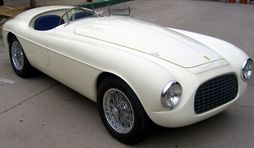
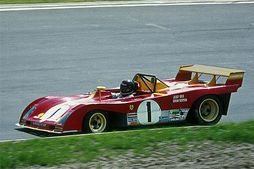

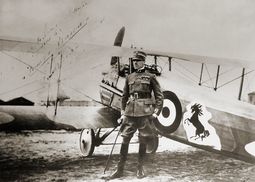

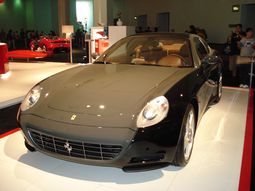
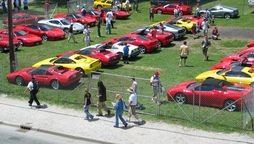
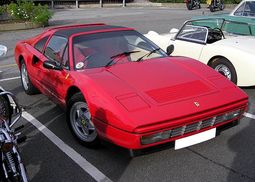
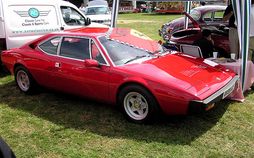
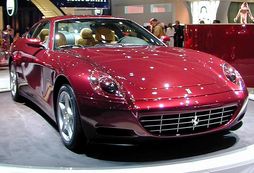
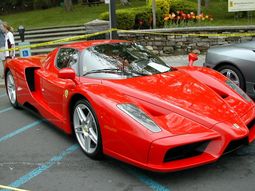
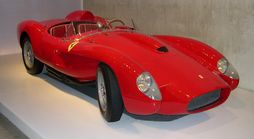
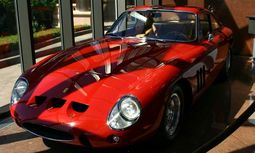
|